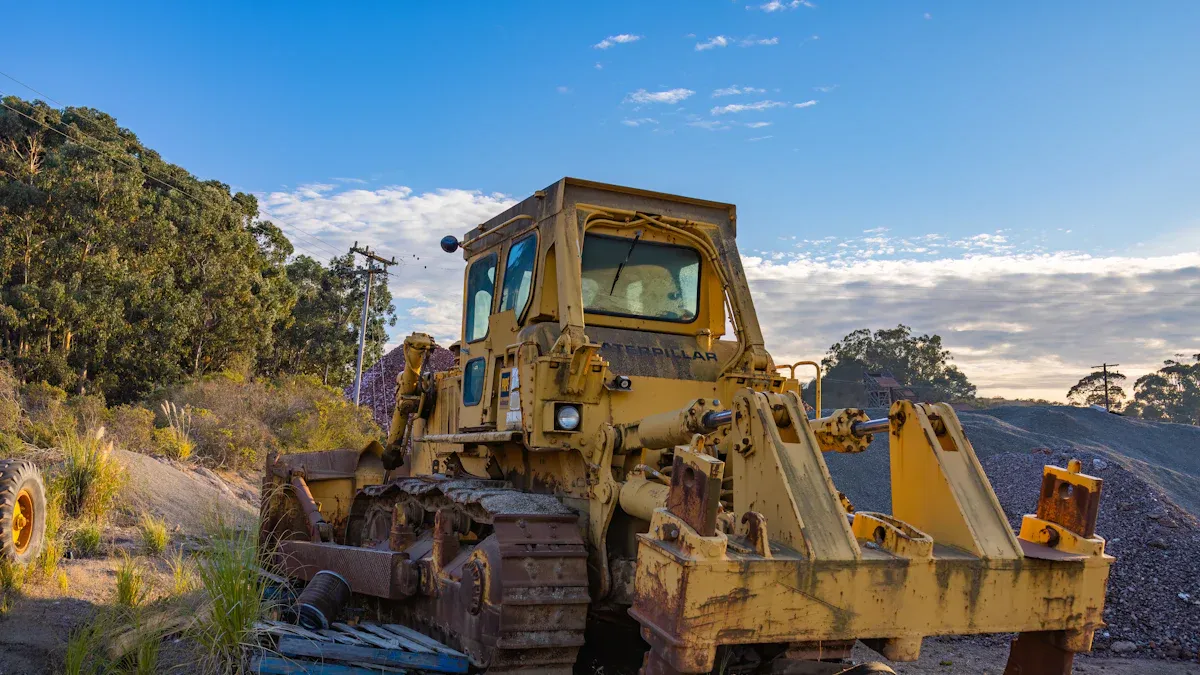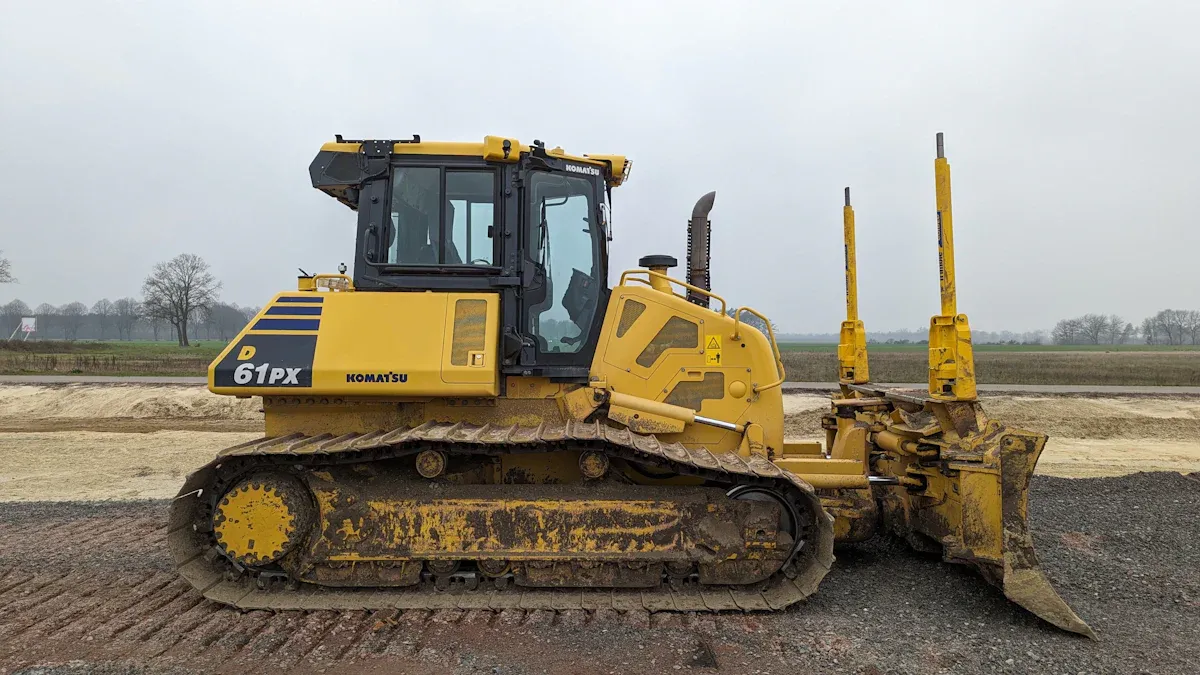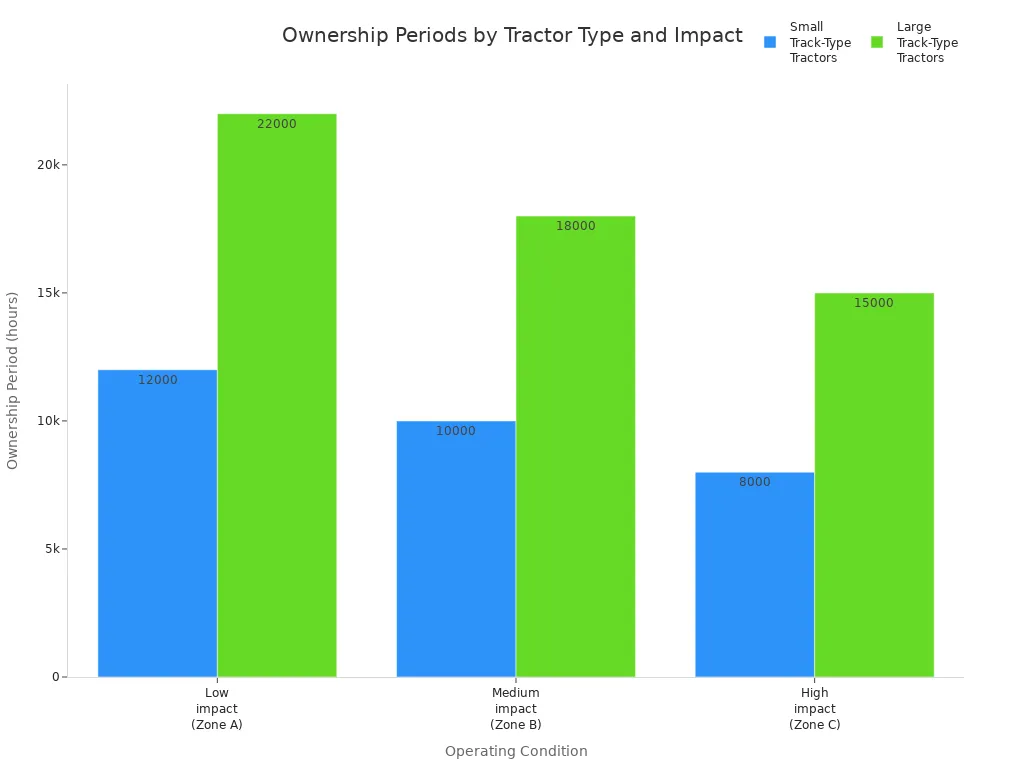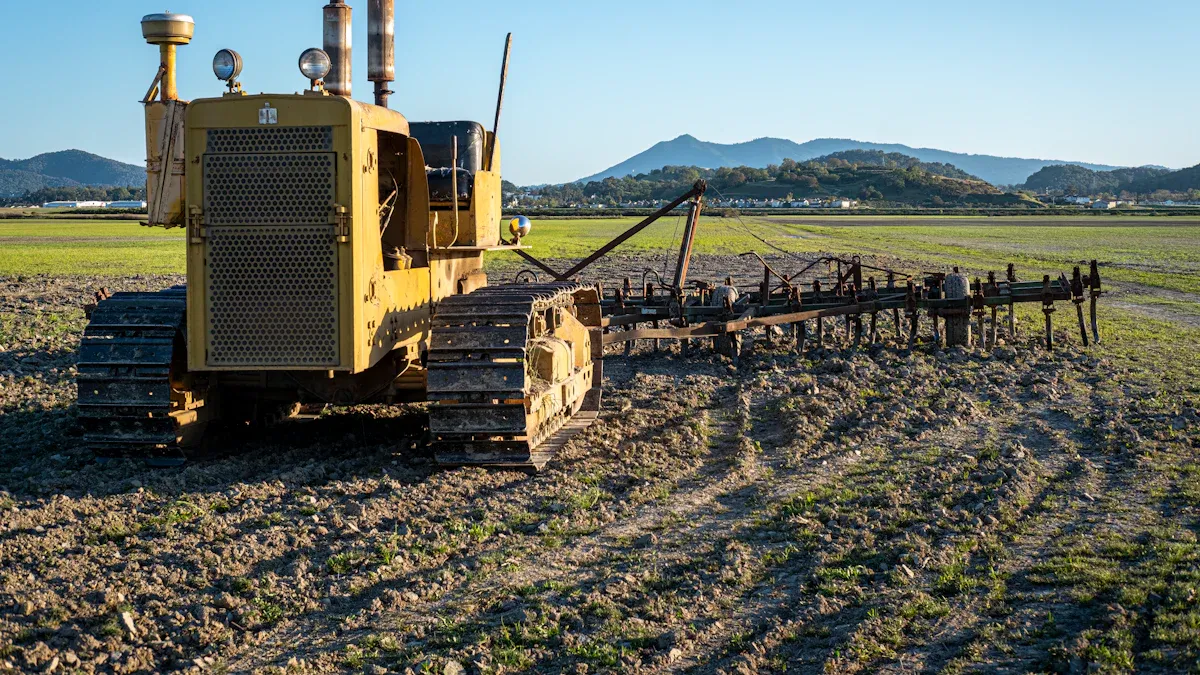English 

T: +86-18367823571
E: lyy@xg1688.cn
E: lyy@xg1688.cn
Building 2, No. 84, Qingxi Dongfeng Road, Qingxi Town, Dongguan City, Guangdong Province, 523642, China



Views: 0 Author: Site Editor Publish Time: 2025-07-18 Origin: Site











A crawler tractor is a strong machine that moves on tracks, not wheels. These tracks help spread out the tractor’s weight. This lets it move over soft or bumpy ground without sinking. Many farmers and builders use crawler tractors for jobs like plowing fields or carrying heavy things. In 2024, the crawler tractor market was worth $3.5 billion. This shows that more people use them in farming and building. Crawler tractors are popular because they can do hard work and work on many types of ground. This makes them very important for today’s farms and building sites.
Crawler tractors use tracks, not wheels, to spread weight. This helps them work on soft or muddy ground. They do not sink easily. They also work well on rough land.
These tractors have strong engines. They have special steering to turn in small spaces. This makes them good for hard jobs on farms. They are also great for building sites.
Crawler tractors protect the soil better than wheeled tractors. They lower ground pressure. This means they cause less soil damage when working.
Picking the right crawler tractor depends on your job. You should think about the soil type and tools you need. Doing regular maintenance helps the tractor last longer. It also saves money.
Modern crawler tractors have new features like GPS and hydraulic systems. These help you work faster. They also make work safer and more efficient.

You might see a crawler tractor on farms or at building sites. This machine moves on tracks, not wheels. The tracks help spread the crawler’s weight over more ground. This makes it easier to drive on soft or bumpy land. The crawler tractor does not sink in mud or loose dirt. Crawler tractors are very strong. They can pull heavy things and do tough jobs. People use them for plowing, tilling, or moving dirt.
The eCFR (29 CFR Part 1926, Subpart W) says crawler tractors are material handling equipment. Construction crawler tractors must follow safety rules, especially if made before July 15, 2019. These rules help keep workers safe when using a crawler tractor.
Crawler tractors have changed a lot over time. Old models had simple diesel engines. Today’s crawlers can have GPS and computer controls. These new features help you work faster and more accurately.
Crawler tractors have many features that help with hard work. Here are some of the most important ones:
Tracks: The tracks give the crawler a big area touching the ground. This means less pressure on the soil and better grip.
Powerful Engines: Most crawler tractors use turbocharged diesel engines. These engines give lots of power at low speeds. This is good for pulling heavy tools.
Smooth Transmission: Many crawlers have power-shift or hydrostatic transmissions. These let you change speed easily and keep steady power.
Hydraulic Systems: You can add many tools to a crawler tractor. The hydraulic system helps you lift, move, or control these tools.
Safety Structures: Modern crawler tractors often have rollover protection. This keeps you safe if the tractor tips over.
Crawler tractors come in different power levels. Here is a table with some engine powers and weights for heavy-duty models:
| Model | Engine Power (hp) | Base Weight (tons) |
|---|---|---|
| MeriCrusher MT-700 | 768 | 22.5 |
| Big Bud 740 | 740 | 34.02 |
| CASE IH Steiger 715 | 715 | 27.7 |
Most crawler tractors fit into three power groups: 0-100 HP, 100-200 HP, and above 200 HP. You can pick the right crawler for your job by how much power you need.
You might wonder how crawler tractors and wheeled tractors are different. Both have good and bad points. The main difference is how they move and what jobs they do best.
| Aspect | Crawler Tractors | Wheeled Tractors |
|---|---|---|
| Mobility and Speed | Best up to 3 mph | Effective speeds 2 to 7 mph |
| Traction and Drawbar Pull | Up to 1.5 times more than wheeled tractors of same weight | Lower traction compared to crawlers |
| Running Gear Cost | Higher (20-25% of total machine cost) | Lower (8-10% of total machine cost) |
| Wear Characteristics | Rapid wear on sandy soils; durable on rocky terrain | Tires last longer and cost less on sandy soils; wear rapidly on rocky terrain |
| Life Expectancy | Approximately 6,400 km (4,000 miles) | Approximately 32,000 km (20,000 miles) |
| Steering | Skid steering or articulated steering (better maneuverability) | Ackermann steering or articulated steering; articulated steering allows turning in place and higher drawbar pull |
| Ground Contact Area | Longer contact area, resulting in greater thrust and less slippage; superior in cohesive soils and difficult terrain | Smaller contact area; better performance in cohesionless soils like sand |
| Preferred Use | Difficult terrain requiring high traction | Speed, economy, and easier maintenance |
Tip: If you need to work on muddy, steep, or rough ground, a crawler tractor gives you better traction and stability. Wheeled tractors work well on dry, flat fields and roads.
Crawler tractors use skid steering, so they can turn in small spaces. Wheeled tractors often use Ackermann or articulated steering. Articulated steering lets wheeled tractors turn in their own length. This makes them flexible, but crawlers are better on tough ground.
Crawler tractors usually last about 18,000 to 20,000 hours if you take care of them. Wheeled tractors often last 15 to 25 years, depending on use and care. Here is a chart that shows how long small and large track-type tractors last in different conditions:

Tracked tractors, like many crawler models, keep their value well. They may cost more at first, but many people find crawlers hold their resale value, especially if you keep them in good shape.
When you look at a crawler tractor, the first thing you notice is the tracks. These tracks help the crawler move over soft, muddy, or uneven ground. Tracks spread the weight of the machine over a larger area than wheels do. This means the crawler does not sink as much into the soil. Scientific studies show that tracks lower ground pressure to about 30–40 kPa, while wheeled tractors can reach 125 kPa. Because of this, you see less soil compaction near the surface when you use a crawler. However, the pressure under tracks is not always even. Sometimes, stiff rollers and bogie wheels create pressure spikes. This can cause small areas of soil damage, especially in very wet fields.
Tracks use strong materials to handle rough terrain. Most tracks combine metal and rubber. The metal gives strength and durability. The rubber adds flexibility and helps reduce vibration. Some advanced crawlers use reinforced polymers to make the tracks lighter but still tough. The undercarriage has many parts, such as links, pins, bushings, sprockets, and rollers. These parts are usually made from high-grade steel. Lubricated pins and bushings help the tracks last longer and work better.
Rubber tracks also help reduce slippage. You get better traction and stability, which means you can work safely on slopes or in muddy fields. The wide tracks keep the crawler steady and make it easier to drive on soft ground. This design helps you finish your work faster and with less risk of getting stuck.
Tip: Tracks work best in soft or uneven terrain. They help you avoid getting stuck and protect the upper soil layer from too much compaction.
A crawler tractor needs a powerful engine to do heavy work. Most crawlers use diesel engines. These engines are often turbocharged and have large cylinders. Diesel engines give you more energy per gallon than gasoline engines. For example, a 60 HP diesel crawler uses about 3.2 gallons of fuel per hour. If you work all day, you might use around 25 gallons. Gasoline engines use about 30% more fuel for the same job. This makes diesel engines a better choice for saving fuel and money.
The engine connects to a strong transmission. Many modern crawlers use hydrostatic or power-shift transmissions. These systems let you change speed smoothly. You can keep steady power, even when you pull heavy tools or drive through tough spots. Some crawlers have electric or hydraulic motors to power the tracks. This helps you get better control and smoother movement.
You will notice that a crawler with a strong power performance can handle big jobs. The engine and transmission work together to give you the force you need. This means you can plow, till, or move heavy loads without slowing down.
Steering a crawler tractor feels different from driving a wheeled tractor. You do not just turn a steering wheel. Instead, you control each track separately. Most crawlers use a system called twin stick braking. When you want to turn, you slow down or stop one track while the other keeps moving. This lets you make very tight turns. In fact, you can turn almost in place. Wheeled tractors need more space to turn, but a crawler can spin around in a small area.
This tight turning radius helps you work in small fields or on terraces. You spend less time turning around, so you finish your work faster. The crawler’s low center of gravity and high grip also give you better stability on slopes. You can climb hills or work on uneven ground without tipping over.
Note: The special steering system of a crawler tractor makes it perfect for jobs in confined spaces or on tricky terrain.
Crawler tractors have great traction and stability. The tracks spread the weight over a big area. This stops the crawler from sinking in soft ground. You can work in mud, loose dirt, or on hills without slipping. The ride feels smoother because the tracks cut down on shaking. Special tread shapes on rubber tracks help grip mud, gravel, snow, and rough land. These treads help you keep good grip, even in tough places. The tracks lower ground pressure by as much as 75%. This protects the soil and stops deep ruts from forming. Crawler tractors let you work on hard ground and keep going when others might get stuck.
Mini skid steer tracks give strong grip and balance on soft or bumpy ground.
Tracks stay flexible in hot or cold weather, so you get steady grip all year.
The suspended undercarriage lets each track move on its own, which helps you stay steady on rough ground.
Crawler tractors give you better grip and balance on soft or bumpy ground, so they are a good pick for tough jobs.
Crawler tractors work well on many kinds of ground. You can use them in mud, sand, or on steep hills. The big area touching the ground gives strong grip and spreads out the weight. This lowers ground pressure and keeps the soil from getting packed down. You can work in tough places where wheeled tractors might have trouble. Crawler tractors are made for rough and tricky ground. They can handle wet fields, loose rocks, and steep hills easily. You get steady work in places where other machines might stop.
| Terrain Type | Crawler Tractors Performance | Wheeled Tractors Performance |
|---|---|---|
| Mud | Great grip, less sinking | Easier to get stuck |
| Sand | Good float, stays steady | Can dig in, lose grip |
| Slopes | Stays steady, less sliding | Less steady, more risk |
Crawler tractors have some downsides too. They move slower than wheeled tractors, especially on hard roads. Moving a crawler is harder because it is big and heavy. Fixing them can cost a lot, since the undercarriage can be half the total cost. You need to check the tracks and drive parts often to keep the crawler working well. Picking the right track width matters for how long it lasts. Narrow tracks last longer but may not work well in soft dirt. Wide tracks are better in soft ground but wear out faster on rocks. Even with these problems, new technology has made crawler tractors work better and last longer.

Crawler tractors are used on many farms today. These machines help get soil ready, plant seeds, and harvest crops. They work well in soft or wet fields where wheeled tractors can get stuck. Big farms use crawler tractors to do more work and make hard jobs easier.
Here are some ways farmers use crawler tractors in agriculture:
Getting soil ready, like rotary tillage and plowing
Planting and seeding in dry or wet fields
Harvesting crops in muddy or sensitive spots
Carrying heavy loads over rough ground
Leveling land to help crops grow better
Farmers like crawler tractors because they have strong grip and stay steady. These tractors work well in muddy soils and on steep hills. More farms use crawler tractors because machines help get more work done. These machines help with soil work and crop care. Many farmers now think crawler tractors are a must-have for modern farming.
Tip: If you want to keep your soil safe and work in tough spots, a crawler tractor is a great tool.
The XG1002-B Tracked Tractor is a strong farm machine from Thinker Agricultural Machinery Co., Ltd. This mini crawler tractor works for many farm jobs. It has a 100hp Xinchai engine, so it has lots of power for hard work. The hydraulic drive lets you turn all the way around, so you can work in small spaces.
The XG1002-B has a low track grounding ratio. This helps stop soil from getting packed down and keeps your fields healthy. The rubber tracks and strong frame help you work in wet or soft places, like rice fields. You can add tools like rotary tillers, plows, and seeders to do many jobs. The XG1002-B is good for rotary tillage, plowing, and making ditches.
Farmers like this tractor because it can do many things and works well. The XG1002-B shows that crawler tractors can handle lots of farm jobs. This machine saves time, keeps soil safe, and helps you get more done. If you need a crawler tractor for your farm, the XG1002-B is a smart pick for your machines.
When picking a crawler tractor, think about what you need. First, decide what jobs you want to do. Some tractors are better for digging or lifting. Others work well in tight spots or on big farms. Look at how big your land is and what kind of soil you have. Thick clay needs a stronger tractor. Sandy soil can use a smaller one.
Here are some things to think about:
Job needs: Write down your main jobs, like plowing or hauling.
Horsepower: Make sure the tractor is strong enough for your tools.
Terrain: See if you need more grip for muddy or rough land.
Attachments: Pick a tractor that can use the tools you want.
Operator safety: Find safety features and get good training.
Maintenance and support: Choose a brand with easy service and parts.
Budget: Decide if you want to buy or rent for your job.
Technology: Some tractors have GPS or save fuel.
Tip: The soil you have matters. Heavy clay needs more power and grip. Lighter soil lets you use a smaller tractor.
Taking care of your tractor saves money and stops breakdowns. Follow a regular plan to keep it working well. Each week, check the tracks, belts, hoses, and fluids. Grease the fittings and test the brakes. Look at the battery and lights. Every month, change the oil and filters. Clean the fuel filter and check the hydraulic and electric parts. Check the coolant and air filters. Make sure the brakes work right.
Here is a table with common problems and fixes:
| Issue | Solution |
|---|---|
| Hydraulic system problems | Check and change fluids, replace filters |
| Electrical faults | Clean wires, swap out old parts |
| Fuel malfunctions | Change filters, use clean fuel |
| Overheating | Watch fluids, fix leaks |
Checking your tractor often helps you find problems early. This makes your tractor last longer and work better. Use real parts and skilled workers to avoid big repair bills. Good care can cut repair costs by up to 25% and keep your tractor ready when you need it.
You now know crawler tractors have strong grip and stay steady on tough ground. People like them because they can work on rough land and do many jobs with one machine. They also help keep the soil from getting packed down.
Crawler tractors have special tracks and smart tools like GPS and joystick controls. These things help you work faster and better.
If you take care of your tractor and learn how to use it, it will last longer.
If you pick a model like the XG1002-B, you get a machine you can trust on your farm. Make sure you think about what features you need, how comfortable it is, and how much work it takes to keep it running. More people are using crawler tractors because new technology makes them better and more useful all over the world.
You get better traction and stability on soft or uneven ground. The tracks spread the weight, so you do not sink or slip. This helps you work in muddy, wet, or hilly fields.
Yes, you can. Crawler tractors work for plowing, tilling, planting, and hauling. You can add tools like rotary tillers, plows, or seeders. This makes your tractor useful for many tasks.
You steer by controlling each track. Slow down or stop one track while the other moves. This lets you turn in tight spaces. Some models use a steering wheel, while others use levers.
Crawler tractors protect the soil better than wheeled tractors. The tracks lower ground pressure, so you see less soil compaction. This keeps your fields healthy and helps crops grow.
Check the tracks and engine every week. Look for wear, loose parts, or leaks. Regular checks help you find problems early and keep your tractor running well.
Tip: Keeping a simple checklist helps you remember what to inspect each week.